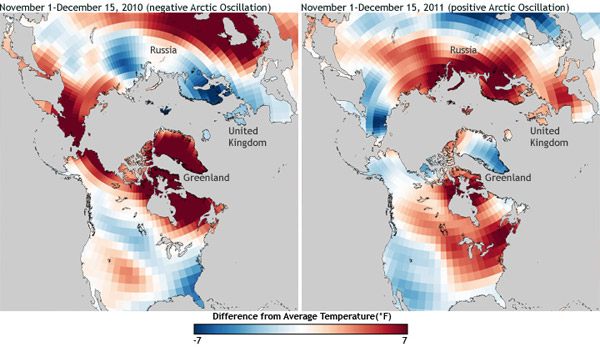
This morning as I was making coffee, I heard birds singing. I didn't smile to myself or do a jaunty heel-kick; I went back to the bedroom to turn off my alarm, which sounds like birds. Nope: it was real birds, ringing in a predicted 55-degree high today—25 degrees higher than the normal high for January 6th, five degrees short of the record set in 2008.
My pick for the Sun-Times weather word of the day was "suspicious." I went to Ask Tom Why, expecting the question of the day to be Dear Tom Skilling, should I be afraid? No, what I got was "this is fantastic, where can I move where it would be like this all the time?"
Being a shut-in, winter puts me on an even field with the rest of humanity, so I have no interest in seeking warmer climes. I want to know where my winter went. And the great Dr. Jeff Masters delivers:
The cause of this warm first half of winter is the most extreme configuration of the jet stream ever recorded, as measured by the North Atlantic Oscillation (NAO). The Arctic Oscillation (AO), and its close cousin, the North Atlantic Oscillation (which can be thought of as the North Atlantic's portion of the larger-scale AO), are climate patterns in the Northern Hemisphere defined by fluctuations in the difference of sea-level pressure in the North Atlantic between the Icelandic Low and the Azores High…. During December 2011, the NAO index was +2.52, which was the most extreme difference in pressure between Iceland and the Azores ever observed in December (records of the NAO go back to 1865.) The AO during December 2011 had its second most extreme December value on record, behind the equally unusual December of 2006.
What should you blame? One theory is that solar activity has a substantial effect on the AO:
Solar activity has increased sharply this winter compared to the past two winters, so perhaps we have seen a strong solar influence on the winter AO the past three winters. Arctic sea ice loss has been linked to the negative (cold) phase of the AO, like we observed the previous two winters. Those winters both had near-record low amounts of sunspot activity, so sea ice loss and low sunspot activity may have combined to bring a negative AO.
Here in Chicago, it was very cold this time of year in 2010 and below average 2011. How does the sun cause changes in atmospheric oscilliations? This will give you an idea:
Previous studies have concluded that changes in solar output over a solar cycle seem to be too small to have much direct impact at Earth's surface. Solar cycle variability is greatest at ultraviolet wavelengths, which are largely absorbed by the stratospheric ozone layer. The direct effects of solar variability are therefore felt predominantly in the stratosphere or higher. However, since the stratosphere is coupled to the troposphere (the lower atmosphere), these changes could also indirectly affect the surface.
[snip]
We find that changes in upper stratospheric ozone and winds affect the flow of energy at altitudes just below these changes, which then affect the next lower levels, and so on. The changes gradually work their way downwards, eventually altering the flow of energy in the lower atmosphere…. The impact on global average temperature seems indeed to be small; however, changing the flow of energy produces large regional impacts.
Basically, the atmospheric layers act as gears: comparatively small increases or decreases in energy absorbtion are magnified as one level turns the one below it. You can actually see how it kind of looks like a series of gears from this diagram. Here's a taste of how it might work, though the variables that drive the gears are many and not well understood:
From 2004 to 2007, during the low points of the last solar cycle, the satellite measured a surprising drop-off in the amount of ultraviolet radiation coming from the sun, roughly five times greater than previously thought.
[snip]
With less ultraviolet radiation, the simulation suggested, parts of the upper atmosphere cooled more than usual and allowed winds to blow more from the east. The anomaly then got bigger and started to burrow down through the atmosphere to altitudes where weather patterns form. There, the changes affected how storms would normally grow, allowing cold weather to form over northern Europe and the United States.
To bring it back around—I think I have this right—it's gone something like this recently: more radiation means warmer air. Warmer air descends more slowly, creating a region of low pressure. Wind flows from high to low pressure, but is "deflected" by the coriolis effect: "In the northern hemisphere they are deflected to toward the right, and fail to arrive at the low pressure center, but instead circulate around it in a counter clockwise fashion as shown here." This is also kind of how it works when the North Atlantic Oscilliation index is really high; both have been extreme recently.
That strong counterclockwise motion keeps the cold air spinning around the Arctic Circle. And makes it 55 degrees here. So why is it warm and sunny? Perhaps because the sun is warm and sunny, too.
Image: NOAA


